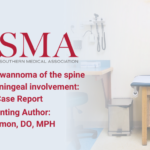Abstract | November 10, 2020
Melanotic schwannoma of the spine with leptomeningeal involvement: Case Report.
Learning Objectives
- Melanotic Schwannomas (MS) are a group of rare melanin producing neoplasms arising from the neural crest cells, accounting for less than one percent of all melanin producing nerve sheath tumors.
- Currently, there are no established guidelines for the management of intramedullary melanotic schwannoma.
- MRI remains the best imaging modality for diagnosing melanotic schwannomas with complete surgical excision of tumor is recommended whenever possible.
Introduction: Melanotic Schwannoma is a rare variant of melanin-producing nerve sheath tumors comprising less than 1% of all nerve sheath tumors. Nerve sheath tumors are generally benign, however 10% can have a malignant transformation. Nerve sheath tumors have an affinity for intradural extramedullary occurrence, however intramedullary tumors are extremely rare and are difficult to treat. There has been only 10 case reports published, so far.
Case Presentation: We present a case of 70-year-old Caucasian female with history of stage 1 lung cancer s/p stereo-tactic radiation therapy and recurrent melanotic schwannoma of the spine s/p radiotherapy and resection of tumor along T7-8, L4 and S1 subsequently, presents with diffuse enhancement of the dura on brain imaging to an oncology follow up, with her husband. Patient has had one-week onset of acute left LE weakness, increased somnolence and worsening of her memory. On examination, patient was drowsy and, oriented only to person and place. Patient was not toxic appearing and demonstrated no aphasia or dysarthria. Patient was lethargic and slow to respond to questions. Cranial nerves were grossly intact with decreased muscle strength throughout, with pronounced weakness noted in the left LE. There were no signs of muscle atrophy, muscle rigidity or sensory deficits. Main differentials included CNS tumors, CVA, hypoglycemia, viral or bacterial meningitis and metabolic encephalopathy.
Subsequent MRI demonstrated bilateral symmetric cortical leptomeningeal enhancement, involving supra and infratentorial regions with dilated ventricles. Blood works were essentially normal except a mild leukocytosis. Lumbar puncture was done and cytology with viral panel was unremarkable. Neurosurgery was consulted and a right frontal sheath guided brain biopsy revealed melanotic neoplasm with a bland spindle cell component, epithelioid morphology and high Ki-67 index. Lesion showed SOX10, Melan A and Olig2 expression with weak S100 labelling. Cytological profile of the tumor was similar to spinal tumor cells done an year prior. A diagnosis of Metastatic Melanotic schwannoma of the spine with leptomeningeal involvement was made.
Treatment & Prognosis: No specific guidelines exist for the management of intramedullary melanotic schwannoma due to its rare occurrence. Complete surgical excision of tumor is recommended whenever possible. Other treatments include immunotherapy, based on melanoma protocols and molecular testing of the tumor. Gamma knife surgery including fractional radiation is an equally effective treatment option for small and medium sized schwannomas near any vital structures. Carboplatin/Etoposide are identified as possible chemotherapeutic regimen in malignant peripheral nerve tumors; however chemotherapy does not seem to provide any mortality benefit overall.
Outcome: Based on Karnofsky Performance Status, patient was not an ideal candidate for aggressive therapy including radiation therapy and/or intrathecal chemotherapy. All the possible treatment options were discussed with the family. Family chose to enroll her in hospice and patient was later transferred to rehabilitation facility for palliative care.

